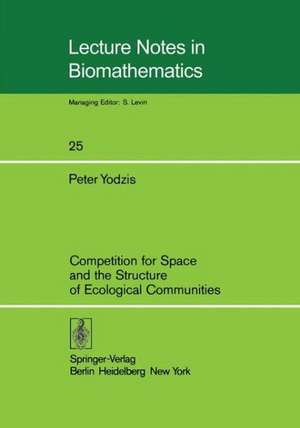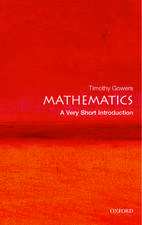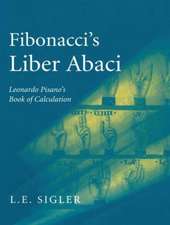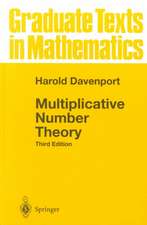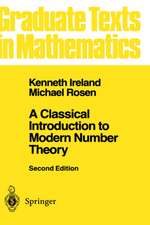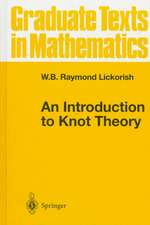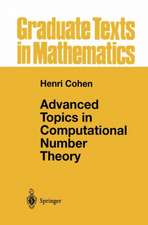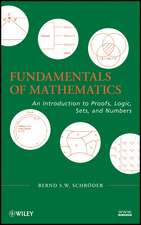Competition for Space and the Structure of Ecological Communities: Lecture Notes in Biomathematics, cartea 25
Autor P. Yodzisen Limba Engleză Paperback – oct 1978
Din seria Lecture Notes in Biomathematics
-
 Preț: 378.54 lei
Preț: 378.54 lei -
 Preț: 380.45 lei
Preț: 380.45 lei -
 Preț: 413.37 lei
Preț: 413.37 lei -
 Preț: 390.63 lei
Preț: 390.63 lei -
 Preț: 396.24 lei
Preț: 396.24 lei -
 Preț: 387.38 lei
Preț: 387.38 lei -
 Preț: 385.08 lei
Preț: 385.08 lei - 5%
 Preț: 366.56 lei
Preț: 366.56 lei -
 Preț: 384.70 lei
Preț: 384.70 lei -
 Preț: 388.13 lei
Preț: 388.13 lei -
 Preț: 394.29 lei
Preț: 394.29 lei - 5%
 Preț: 389.93 lei
Preț: 389.93 lei - 5%
 Preț: 370.74 lei
Preț: 370.74 lei -
 Preț: 384.86 lei
Preț: 384.86 lei -
 Preț: 387.96 lei
Preț: 387.96 lei -
 Preț: 404.29 lei
Preț: 404.29 lei -
 Preț: 391.61 lei
Preț: 391.61 lei -
 Preț: 384.48 lei
Preț: 384.48 lei -
 Preț: 383.71 lei
Preț: 383.71 lei -
 Preț: 379.68 lei
Preț: 379.68 lei -
 Preț: 384.09 lei
Preț: 384.09 lei -
 Preț: 405.66 lei
Preț: 405.66 lei -
 Preț: 379.48 lei
Preț: 379.48 lei -
 Preț: 400.65 lei
Preț: 400.65 lei -
 Preț: 385.25 lei
Preț: 385.25 lei -
 Preț: 390.25 lei
Preț: 390.25 lei -
 Preț: 395.47 lei
Preț: 395.47 lei -
 Preț: 378.71 lei
Preț: 378.71 lei -
 Preț: 382.95 lei
Preț: 382.95 lei - 15%
 Preț: 578.01 lei
Preț: 578.01 lei -
 Preț: 380.84 lei
Preț: 380.84 lei -
 Preț: 405.66 lei
Preț: 405.66 lei -
 Preț: 399.12 lei
Preț: 399.12 lei -
 Preț: 410.66 lei
Preț: 410.66 lei -
 Preț: 385.62 lei
Preț: 385.62 lei - 5%
 Preț: 371.10 lei
Preț: 371.10 lei -
 Preț: 378.71 lei
Preț: 378.71 lei -
 Preț: 386.99 lei
Preț: 386.99 lei -
 Preț: 401.61 lei
Preț: 401.61 lei -
 Preț: 350.30 lei
Preț: 350.30 lei -
 Preț: 383.33 lei
Preț: 383.33 lei -
 Preț: 408.54 lei
Preț: 408.54 lei -
 Preț: 398.53 lei
Preț: 398.53 lei -
 Preț: 399.67 lei
Preț: 399.67 lei -
 Preț: 391.79 lei
Preț: 391.79 lei -
 Preț: 384.86 lei
Preț: 384.86 lei -
 Preț: 401.61 lei
Preț: 401.61 lei -
 Preț: 392.60 lei
Preț: 392.60 lei -
 Preț: 406.05 lei
Preț: 406.05 lei
Preț: 384.48 lei
Nou
Puncte Express: 577
Preț estimativ în valută:
73.59€ • 79.97$ • 61.86£
73.59€ • 79.97$ • 61.86£
Carte tipărită la comandă
Livrare economică 21 aprilie-05 mai
Preluare comenzi: 021 569.72.76
Specificații
ISBN-13: 9783540089360
ISBN-10: 3540089365
Pagini: 204
Ilustrații: VI, 194 p.
Dimensiuni: 170 x 244 x 11 mm
Greutate: 0.33 kg
Ediția:Softcover reprint of the original 1st ed. 1978
Editura: Springer Berlin, Heidelberg
Colecția Springer
Seria Lecture Notes in Biomathematics
Locul publicării:Berlin, Heidelberg, Germany
ISBN-10: 3540089365
Pagini: 204
Ilustrații: VI, 194 p.
Dimensiuni: 170 x 244 x 11 mm
Greutate: 0.33 kg
Ediția:Softcover reprint of the original 1st ed. 1978
Editura: Springer Berlin, Heidelberg
Colecția Springer
Seria Lecture Notes in Biomathematics
Locul publicării:Berlin, Heidelberg, Germany
Public țintă
ResearchCuprins
I. Introduction.- I.1. Competition for space..- I.2. Spatial competition and the niche..- I.3. Modelling competition for space..- I.4. Limitations of this study..- I.5. Colonization..- I.6. Preview..- II. Founder Controlled Communities.- II.1. Colonization equilibria..- II.2. Stability..- II.3. Total standing crop..- II.4. Summary..- III. Dominance Controlled Communities.- III.1. Numerical dominance and functional dominance..- III.2. The reshuffle..- III.3. Quasicycles and lotteries..- III.4. Equilibrium communities..- III.5. Invasion and succession..- III.6. Other forms of dispersa..- III.7. Summary..- IV. Harvesting.- IV.1. Harvesting..- IV.2. The reshuffle..- IV.3. Influence of harvesting: theoretical..- IV.4. Species richness: observational..- IV.5. Disturbance..- IV.6. Summary..- V. Epilogue.- V.1. Spatial competition and the niche reconsidered..- V.2. Species packing and the relation between plant and animal diversity..- V.3. Evolutionary considerations and the tropical rain forest..- Appendix A. Perturbation Theory.- A.1. Perturbed equilibria..- A.2. Perturbed stability matrices..- A.2.1. Semisimple eigenvalues..- A.2.2. Existence of linear perturbations..- A.2.3. Calculation of linear perturbations..- A.3. Calculation of A..- A.3.1. Colonization equilibria..- A.3.2. Reshuffled equilibria..- Appendix B. Some Lotka-Volterra Formulae.- B.1. One-species equilibria..- B.2. Two-species equilibria..- Appendix C. Harvesting and Two-Species Interactions.- Author Index.
